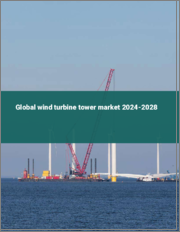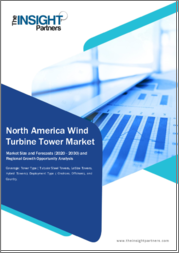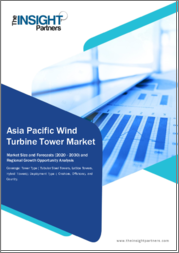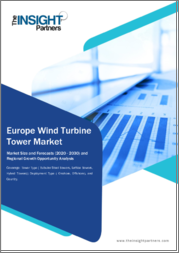
|
시장보고서
상품코드
1804684
해상 터빈 타워 시장 : 타워 유형, 재료 유형, 타워 높이, 최종 용도별 - 세계 예측(2025-2030년)Offshore Turbine Towers Market by Tower Type, Material Type, Tower Height, End Use - Global Forecast 2025-2030 |
||||||
해상 터빈 타워 시장은 2024년에 82억 9,000만 달러로 평가되며, 2025년에는 88억 3,000만 달러, CAGR 6.75%로 성장하며, 2030년에는 122억 8,000만 달러에 달할 것으로 예측됩니다.
| 주요 시장 통계 | |
|---|---|
| 기준연도 2024 | 82억 9,000만 달러 |
| 추정연도 2025 | 88억 3,000만 달러 |
| 예측연도 2030 | 122억 8,000만 달러 |
| CAGR(%) | 6.75% |
지속가능한 에너지 인프라로의 세계 전환을 가속화하는 해상 터빈 타워의 중요한 역할에 대한 이해
해상 터빈타워는 재생에너지 발전을 위해 강력한 해풍을 이용하는 풍력 터빈의 중요한 지지 구조물로서 전 세계 에너지 전환의 초석으로 빠르게 부상하고 있습니다. 이 타워는 터빈의 안정적이고 효율적인 운전을 가능하게 하는 동시에 강풍과 부식성 해수 조건과 같은 극심한 환경 부하를 견뎌내야 합니다. 각국이 이산화탄소 배출량 감축에 대한 노력을 강화하는 가운데 해상풍력발전 설비에 대한 수요가 증가하면서 터빈 타워의 성능을 지원하는 엔지니어링, 물류, 재료에 대한 관심이 다시금 높아지고 있습니다.
해상 터빈 타워 개발 및 세계 진출 전략을 재정의하는 기술 및 시장 파괴를 살펴봅니다.
최근 수년간 해양 터빈 타워를 둘러싼 환경은 급속한 기술 발전과 진화하는 시장 수요에 힘입어 큰 변화를 겪고 있습니다. 유한요소해석, 디지털 트윈과 같은 디지털 엔지니어링의 혁신으로 가혹한 해양 조건에서 구조물의 성능을 보다 정확하게 모델링할 수 있게 되었습니다. 그 결과, 이러한 능력은 설계 반복을 가속화하고, 신소재 채택을 촉진하며, 무게와 제조 비용을 모두 절감할 수 있게 되었습니다.
미국의 해양 터빈 타워에 대한 새로운 관세 부과가 가져올 광범위한 경제적, 전략적 영향 분석
미국이 2025년 새로운 관세를 도입함에 따라 해상 터빈타워 산업은 다각적인 경제적, 전략적 영향을 받게 되었습니다. 당초 원자재 및 가공된 타워 부품에 대한 수입 과세는 부품 비용 상승 압력을 가하여 제조업체와 개발업체에 조달 전략의 재검토를 요구했습니다. 이에 따라 일부 주요 업체들은 국내 생산 능력을 가속화하거나 관세의 영향을 받지 않는 국가의 대체 공급업체를 찾아 세계 조달 네트워크를 재구축하고 있습니다.
해양 터빈 타워의 유형별, 소재별, 높이별, 최종 용도별 종합적인 세분화 분석을 통해 시장 역학 파악
오프쇼어 터빈 타워 시장은 다양한 세분화를 통해 검증되면 명확한 역학이 드러납니다. 타워 유형별로는 얕은 해역에서는 여전히 고정식 타워가 주류를 이루고 있습니다. 이 중 모노파일 기초는 합리적인 설치 공정으로 인해 수심 40미터까지 선호되는 반면, 재킷 구조는 제작의 복잡성은 증가하지만 중거리 수심에서 우수한 안정성을 제공합니다. 한편, 부력식 시스템은 부력식 플랫폼과 동적 계류라인을 활용하여 수심 60미터 이상의 심해 현장에서 각광받고 있습니다.
아메리카, 유럽, 중동 및 아프리카, 아시아태평양의 해상 터빈 타워 개발에 영향을 미치는 지역적 차이와 비즈니스 기회
해양 터빈타워 시장은 규제 프레임워크, 자원의 가용성, 투자 의지에 따라 지역별로 뚜렷한 차이를 보이고 있습니다. 북미와 남미에서는 연방정부와 주정부 차원의 야심찬 재생에너지 목표가 양 해안의 새로운 해양 프로젝트를 촉진하고 있습니다. 인프라 투자는 타워 조립 및 스테이징을 지원하기 위한 국내 제조 시설과 항만 확장에 집중되고 있으며, 허가 절차의 간소화로 프로젝트 승인이 가속화되고 있습니다.
해양 터빈 타워 분야의 주요 기업을 정의하는 경쟁 차별화 요소와 협력적 노력의 전략적 구상 공개
해양 터빈 타워 분야의 주요 기업은 전략적 구상을 활용하여 시장에서의 입지를 강화하고 혁신을 가속화하고 있습니다. 세계 철강업체들은 고강도 합금 요구사항과 타워의 대형화에 대응하기 위해 생산능력 확대 및 생산라인의 현대화를 발표했습니다. 이러한 투자는 차세대 소재 및 디지털 제조 기술에 초점을 맞춘 공동 연구센터의 설립으로 보완됩니다.
혁신을 강화하고, 공급망을 최적화하며, 해양 터빈 타워 산업의 지속가능한 성장을 가속하기 위한 실행 가능한 전략을 제공
업계 리더는 경쟁력을 유지하고 지속가능한 성장을 추진하기 위해 첨단인 전략을 채택해야 합니다. 부유식 기초기술에 대한 투자를 우선시함으로써 심해풍력 자원에 대한 접근성을 확보하고, 프로젝트 포트폴리오를 다양화하며, 고정식 해저 설치에 따른 입지 제약을 완화할 수 있습니다. 동시에 재료 공급업체와의 관계를 강화하고 공동 개발 계약을 촉진하여 공급망의 탄력성과 비용 예측 가능성을 확보할 수 있습니다.
해양 터빈 타워 시장 조사를 지원하는 엄격한 조사 설계 데이터 수집 프로세스 및 분석 프레임워크에 대한 설명
본 조사에서는 종합적인 조사 범위와 분석의 엄밀성을 확보하기 위해 1차 조사와 2차 조사를 결합한 다면조사 방식을 채택했습니다. 이 과정은 업계 간행물, 기술 논문, 규제 당국 제출 서류, 업계 단체 보고서 등 광범위한 검토를 통해 탄탄한 2차 데이터베이스을 구축하는 것으로 시작되었습니다. 이 배경 조사는 1차 조사 방법론 설계에 반영되어 주요 시장 가설을 검증하는 데 도움이 되었습니다.
해양 터빈타워 동향에 대한 심층 분석을 통해 얻은 주요 인사이트 요약 이해관계자들에 대한 시사점 및 향후 방향성 제시
이 보고서는 기술 발전, 정책 영향, 세분화 분석, 지역 역학, 경쟁 전략에 대한 인사이트을 통합하여 해양 터빈 타워의 상황을 종합적으로 이해합니다. 고정형과 부유식 솔루션의 상호 작용은 설계 적응성의 중요성을 강조하고, 재료의 혁신은 성능과 비용 효율성을 향상시킬 수 있는 길을 제시합니다.
목차
제1장 서문
제2장 조사 방법
제3장 개요
제4장 시장 개요
제5장 시장 역학
제6장 시장 인사이트
- Porter's Five Forces 분석
- PESTEL 분석
제7장 미국 관세의 누적 영향 2025
제8장 해상 터빈 타워 시장 : 타워 유형별
- 고정바닥
- 재킷
- 모노파일
- 삼각
- 플로팅
제9장 해상 터빈 타워 시장 : 재료 유형별
- 콘크리트
- 하이브리드
- 철강
제10장 해상 터빈 타워 시장 : 타워 높이
- 80미터 이상
- 80미터 이하
제11장 해상 터빈 타워 시장 : 최종 용도별
- 정부 해상 풍력발전소
- 민간 해상 풍력발전소
제12장 아메리카의 해상 터빈 타워 시장
- 미국
- 캐나다
- 멕시코
- 브라질
- 아르헨티나
제13장 유럽, 중동 및 아프리카의 해상 터빈 타워 시장
- 영국
- 독일
- 프랑스
- 러시아
- 이탈리아
- 스페인
- 아랍에미리트
- 사우디아라비아
- 남아프리카공화국
- 덴마크
- 네덜란드
- 카타르
- 핀란드
- 스웨덴
- 나이지리아
- 이집트
- 튀르키예
- 이스라엘
- 노르웨이
- 폴란드
- 스위스
제14장 아시아태평양의 해상 터빈 타워 시장
- 중국
- 인도
- 일본
- 호주
- 한국
- 인도네시아
- 태국
- 필리핀
- 말레이시아
- 싱가포르
- 베트남
- 대만
제15장 경쟁 구도
- 시장 점유율 분석, 2024
- FPNV 포지셔닝 매트릭스, 2024
- 경쟁 분석
- Ambau GmbH
- Broadwind, Inc.
- CS Wind Corporation
- Dajin Heavy Industry Corporation
- Dongkuk S&C Co., Ltd.
- EEW Special Pipe Constructions GmbH
- EEW Special Pipe Constructions GmbH
- Esteyco S.A.
- GE Vernova
- Goldwind Science & Technology Co., Ltd.
- GRI Renewable Industries
- Haizea Wind Group
- Hyundai Steel Company
- Keystone Tower Systems
- Lamprell PLC
- Larsen & Toubro Limited
- Pemamek Ltd
- Qingdao Wuxiao Group Co., Ltd.
- SeAH Steel Holdings Corporation
- Shanghai Electric Group Co., Ltd.
- SM Industries A/S
- Smulders NV
- Vestas Wind Systems A/S
- Welcon A/S
- Windar Renovables S.A.
제16장 리서치 AI
제17장 리서치 통계
제18장 리서치 컨택
제19장 리서치 기사
제20장 부록
KSA 25.09.17The Offshore Turbine Towers Market was valued at USD 8.29 billion in 2024 and is projected to grow to USD 8.83 billion in 2025, with a CAGR of 6.75%, reaching USD 12.28 billion by 2030.
| KEY MARKET STATISTICS | |
|---|---|
| Base Year [2024] | USD 8.29 billion |
| Estimated Year [2025] | USD 8.83 billion |
| Forecast Year [2030] | USD 12.28 billion |
| CAGR (%) | 6.75% |
Understanding the Critical Role of Offshore Turbine Towers in Accelerating the Global Transition to Sustainable Energy Infrastructure
Offshore turbine towers are rapidly emerging as a cornerstone of the global energy transformation, serving as the critical support structures for wind turbines that harness powerful sea breezes to generate renewable electricity. These towering structures must withstand intense environmental loads, including high winds and corrosive saltwater conditions, while enabling stable and efficient turbine operation. As nations increasingly commit to reducing carbon emissions, the demand for offshore wind installations is climbing, driving renewed focus on the engineering, logistics, and materials that underpin turbine tower performance.
The introduction of larger and more powerful turbines has intensified the complexity of tower design. Taller towers with enhanced load-bearing capacity allow for the deployment of high-capacity rotors, boosting energy yield per installation. Consequently, innovation in materials and construction techniques is essential to optimize weight-to-strength ratios, extend service life, and minimize maintenance costs. Equally important, project timelines and investment horizons are shifting in response to evolving regulatory frameworks, public-private partnerships, and sustainability mandates.
This executive summary provides a concise overview of the critical factors shaping the offshore turbine tower market. It establishes the foundational context for the subsequent sections, which delve into market shifts, policy impacts, segmentation insights, regional dynamics, competitive landscapes, strategic recommendations, methodological rigor, and final conclusions. Collectively, these insights offer decision-makers a holistic perspective on how to navigate the complexities of this rapidly advancing sector.
Examining the Technological and Market Disruptions Redefining Offshore Turbine Tower Development and Deployment Strategies Worldwide
In recent years, the offshore turbine tower landscape has undergone profound shifts driven by rapid technological advancement and evolving market demands. Innovations in digital engineering, such as finite element analysis and digital twins, have enabled more precise modeling of structural performance under extreme marine conditions. These capabilities, in turn, have accelerated design iterations and facilitated the adoption of novel materials, reducing both weight and fabrication costs.
Simultaneously, supply chain integration has become a strategic focal point. Enhanced collaboration between steel fabricators, logistics providers, and port operators is streamlining manufacturing and delivery processes, shortening lead times and mitigating project delays. Furthermore, the rise of floating turbine concepts is expanding the geographical scope of offshore wind, allowing deployment in deeper waters where traditional fixed-bottom towers are impractical. This shift is opening up new offshore territories, fostering investment in adaptable foundation systems suited for platform-based installations.
Moreover, environmental and social governance imperatives have gained prominence, prompting developers to prioritize low-carbon manufacturing processes and lifecycle assessments. As a result, repowering strategies-where legacy turbines are replaced with higher-capacity systems on existing foundations-are being actively explored to optimize asset utilization and reduce environmental footprints. Taken together, these transformative forces are redefining how stakeholders conceptualize, design, and execute offshore turbine tower projects, establishing a dynamic market environment characterized by continual innovation and strategic collaboration.
Analyzing the Broad Economic and Strategic Consequences of New United States Tariffs on Offshore Turbine Towers Effective from Twenty Twenty Five
The introduction of new tariffs by the United States in 2025 has created a multifaceted set of economic and strategic implications for the offshore turbine tower industry. Initially, import levies on raw materials and fabricated tower sections have exerted upward pressure on component costs, compelling manufacturers and developers to reassess sourcing strategies. In response, some key players are accelerating domestic production capabilities or seeking alternative suppliers in nations unaffected by the tariffs, reshaping global procurement networks.
In addition, the increased cost burden has prompted greater emphasis on value engineering and design optimization. Tower fabricators are leveraging advanced welding techniques and high-strength alloys to reduce material usage without compromising structural integrity. These efforts serve to offset tariff-related expenses while maintaining competitive pricing for project tenders.
Moreover, the policy shift has influenced investment decisions and partnership models. Joint ventures between tower producers and offshore wind developers now often include provisions for localized manufacturing to navigate trade barriers, fostering greater onshore job creation and regional economic benefits. At the same time, project financiers are scrutinizing tariff exposure more closely, integrating scenario analyses into their risk management frameworks.
Ultimately, while the newly enacted tariffs introduce short-term cost challenges, they are catalyzing innovation in supply chain resilience and domestic capabilities. By embracing adaptive strategies, the offshore turbine tower ecosystem is evolving toward a more diversified and strategically balanced global marketplace.
Deriving Insight into Market Dynamics through Comprehensive Segmentation Analysis of Offshore Turbine Towers by Type Material Height and End Use
The offshore turbine tower market reveals distinct dynamics when examined through various segmentation lenses. In terms of tower type, fixed-bottom solutions remain the predominant choice for shallower waters. Among these, monopile foundations are favored for depths up to 40 meters due to their streamlined installation process, while jacket structures offer superior stability in mid-range depths, albeit at a higher fabrication complexity. Tripod configurations serve niche applications, addressing specific seabed conditions, whereas floating systems are gaining traction for deepwater sites beyond 60 meters, leveraging buoyant platforms and dynamic mooring lines.
Material considerations are equally pivotal. Steel continues to dominate due to its high strength-to-weight ratio and well-established fabrication infrastructure. However, concrete towers are making inroads in regions with abundant raw materials and cost advantages, favored for their corrosion resistance and lifecycle durability. Hybrid designs that combine steel and concrete elements are emerging as a compromise, blending the benefits of both materials to optimize transportation and on-site assembly.
Tower height segmentation also influences project economics and energy output. Towers exceeding 80 meters unlock higher wind speeds and reduced turbulence, translating into greater annual energy production. Conversely, installations featuring heights at or below 80 meters remain relevant in zones with lower average wind velocities or where installation vessel availability constrains taller fabrication.
End-use differentiation further shapes procurement patterns. Government-sponsored offshore wind farms often prioritize proven technologies and stringent certification standards, driving demand for robust fixed-bottom and steel-dominated towers. In contrast, private sector developers display greater willingness to pilot innovative floating and hybrid designs, seeking to capitalize on first-mover advantages and bespoke project optimizations.
Highlighting Regional Variations and Opportunities Impacting Offshore Turbine Tower Development across Americas Europe Middle East Africa and Asia Pacific
The offshore turbine tower market exhibits pronounced regional distinctions based on regulatory frameworks, resource availability, and investment appetites. In the Americas, ambitious federal and state-level renewable energy targets have catalyzed new offshore projects along both coasts. Infrastructure investment is channeled toward domestic manufacturing facilities and port expansions to support tower assembly and staging, while streamlined permitting processes are accelerating project approvals.
Across Europe Middle East and Africa, mature offshore wind markets in Northern Europe continue to drive incremental growth in tower capacity and advanced foundation technologies. Meanwhile, emerging markets in the Mediterranean and Gulf regions are exploring pilot floating turbine farms to harness deeper offshore wind resources. Collaborative initiatives between governments and private investors are facilitating demonstration projects and technology transfer.
Within Asia Pacific, rapid urbanization and increasing energy demand are propelling Southeast Asia and East Asia toward significant offshore wind deployment. Nations with expansive coastlines are incentivizing local content requirements, promoting the development of regional steel fabrication hubs and marine logistics services. In parallel, Australia's commitment to renewable exports is fostering partnerships between domestic steel producers and international turbine OEMs to cultivate a robust offshore supply chain.
Collectively, these regional patterns underscore the importance of tailoring tower design, material sourcing, and logistical planning to local conditions and policy landscapes. Stakeholders that align their strategies with regional imperatives are best positioned to capture growth opportunities and achieve long-term project success.
Unveiling the Strategic Initiatives Competitive Differentiators and Collaborative Efforts Defining Key Players in the Offshore Turbine Tower Sector
Leading companies in the offshore turbine tower sector are leveraging strategic initiatives to strengthen their market positions and accelerate innovation. Several global steel fabricators have announced capacity expansions and modernization of production lines to accommodate higher-strength alloy requirements and larger tower segments. These investments are complemented by the establishment of collaborative research centers focused on next-generation materials and digital manufacturing techniques.
In parallel, tower manufacturers are forging alliances with offshore wind farm developers and engineering firms to co-develop integrated foundation solutions. Such partnerships enable early-stage alignment on design specifications, reduce interface risks during installation, and enhance project delivery certainty. Additionally, some industry players are entering joint ventures with port operators to secure dedicated staging areas, optimizing logistics and minimizing on-site handling times.
On the technological front, companies are piloting advanced coating systems and sensor-enabled monitoring platforms to improve corrosion resistance and enable predictive maintenance models. These innovations aim to lower lifecycle costs and extend operational uptime by identifying potential issues before they escalate into critical failures.
Furthermore, a number of firms are expanding their service portfolios to include comprehensive tower inspection, repair, and repowering offerings. By providing end-to-end lifecycle solutions, they are building deeper client relationships and creating recurring revenue streams. Together, these competitive differentiators and collaborative efforts are reshaping the competitive landscape and setting new benchmarks for performance and reliability in offshore turbine tower delivery.
Providing Actionable Strategies to Enhance Innovation Optimize Supply Chains and Drive Sustainable Growth within the Offshore Turbine Tower Industry
Industry leaders must adopt forward-thinking strategies to remain competitive and drive sustainable growth. Prioritizing investment in floating foundation technologies can unlock access to deepwater wind resources, diversifying project portfolios and mitigating site constraints associated with fixed-bottom installations. At the same time, strengthening relationships with material suppliers and foster joint development agreements to secure supply chain resilience and cost predictability.
Furthermore, embracing digitalization within design and fabrication workflows is critical. Implementing digital twin platforms allows real-time performance simulations and enhances quality control, reducing rework and accelerating project schedules. Concurrently, integrating advanced sensor networks into tower structures supports condition-based maintenance strategies, lowering downtime and lifecycle expenditures.
To maximize value, developers should engage proactively with regulatory bodies to shape favorable policy frameworks and streamline approval processes. Establishing public-private partnerships for demonstration projects can showcase emerging technologies, attract investment, and cultivate societal acceptance. Finally, expanding service offerings to include comprehensive repowering and decommissioning solutions will position companies as full-spectrum partners across the asset lifecycle, creating new revenue streams and reinforcing client loyalty.
By executing these actionable recommendations, industry stakeholders can optimize operational efficiencies, fortify competitive advantages, and ensure long-term viability in an increasingly dynamic offshore wind environment.
Describing the Rigorous Research Design Data Collection Processes and Analytical Framework Underpinning the Offshore Turbine Tower Market Investigation
This research employed a multi-faceted methodology combining primary and secondary data collection to ensure comprehensive coverage and analytical rigor. The process began with an extensive review of industry publications, technical papers, regulatory filings, and trade association reports to establish a robust secondary data foundation. This background research informed the design of primary research instruments and validated key market hypotheses.
Primary insights were gathered through in-depth interviews with executives from turbine manufacturers, foundation engineering firms, offshore developers, procurement specialists, and regulatory authorities. These qualitative discussions provided granular perspectives on design challenges, policy impacts, and emerging technology adoption. Interview data were then cross-validated against quantitative datasets, including shipment volumes, project pipelines, and capital expenditure trends, to maintain data integrity.
Subsequently, advanced analytical techniques such as scenario analysis and sensitivity testing were applied to assess the implications of tariff changes, material cost fluctuations, and regional policy shifts. Data triangulation was performed throughout to reconcile discrepancies and reinforce confidence in the findings. Finally, the research underwent multiple peer reviews by subject matter experts to ensure accuracy, relevance, and unbiased interpretation of results.
Summarizing the Critical Insights Derived from In Depth Analysis of Offshore Turbine Tower Trends Implications and Future Directions for Stakeholders
By synthesizing insights across technological advancements, policy influences, segmentation analyses, regional dynamics, and competitive strategies, this report delivers a holistic understanding of the offshore turbine tower landscape. The interplay between fixed-bottom and floating solutions underscores the importance of design adaptability, while material innovations reveal pathways to enhance performance and cost efficiency.
Furthermore, the examination of tariff impacts highlights the need for agile supply chain management and domestic capability development. Regional assessments demonstrate how regulatory frameworks and local content requirements shape investment flows, reiterating the value of tailored market entry approaches. At the same time, leading companies are setting new standards through collaborative ventures, digitalization initiatives, and lifecycle service expansion, indicating a shift toward integrated solutions and value-added partnerships.
Looking ahead, continued innovation in foundation technologies, coupled with strategic policy engagement and robust risk management practices, will be critical for the sector's success. Stakeholders that proactively align their strategies with emerging trends and regulatory contexts will unlock significant competitive advantages. Ultimately, the offshore turbine tower industry stands poised for sustained growth, driven by global decarbonization goals and the relentless pursuit of operational excellence.
Table of Contents
1. Preface
- 1.1. Objectives of the Study
- 1.2. Market Segmentation & Coverage
- 1.3. Years Considered for the Study
- 1.4. Currency & Pricing
- 1.5. Language
- 1.6. Stakeholders
2. Research Methodology
- 2.1. Define: Research Objective
- 2.2. Determine: Research Design
- 2.3. Prepare: Research Instrument
- 2.4. Collect: Data Source
- 2.5. Analyze: Data Interpretation
- 2.6. Formulate: Data Verification
- 2.7. Publish: Research Report
- 2.8. Repeat: Report Update
3. Executive Summary
4. Market Overview
- 4.1. Introduction
- 4.2. Market Sizing & Forecasting
5. Market Dynamics
- 5.1. Emergence of floating offshore wind turbine towers for deepwater applications
- 5.2. Integration of hybrid jacket and monopile foundations for cost optimization
- 5.3. Advancements in turbine tower modular assembly for reduced offshore installation time
- 5.4. Use of high-strength low-alloy steel in turbine towers to improve fatigue resistance
- 5.5. Growing adoption of digital twin technology for predictive maintenance of tower structures
- 5.6. Shift toward larger 15-plus megawatt turbines driving demand for taller towers
- 5.7. Rising offshore logistics constraints influencing onshore manufacturing of tower segments
6. Market Insights
- 6.1. Porter's Five Forces Analysis
- 6.2. PESTLE Analysis
7. Cumulative Impact of United States Tariffs 2025
8. Offshore Turbine Towers Market, by Tower Type
- 8.1. Introduction
- 8.2. Fixed Bottom
- 8.2.1. Jacket
- 8.2.2. Monopile
- 8.2.3. Tripod
- 8.3. Floating
9. Offshore Turbine Towers Market, by Material Type
- 9.1. Introduction
- 9.2. Concrete
- 9.3. Hybrid
- 9.4. Steel
10. Offshore Turbine Towers Market, by Tower Height
- 10.1. Introduction
- 10.2. >80 M
- 10.3. <=80 M
11. Offshore Turbine Towers Market, by End Use
- 11.1. Introduction
- 11.2. Government Offshore Wind Farms
- 11.3. Private Offshore Wind Farms
12. Americas Offshore Turbine Towers Market
- 12.1. Introduction
- 12.2. United States
- 12.3. Canada
- 12.4. Mexico
- 12.5. Brazil
- 12.6. Argentina
13. Europe, Middle East & Africa Offshore Turbine Towers Market
- 13.1. Introduction
- 13.2. United Kingdom
- 13.3. Germany
- 13.4. France
- 13.5. Russia
- 13.6. Italy
- 13.7. Spain
- 13.8. United Arab Emirates
- 13.9. Saudi Arabia
- 13.10. South Africa
- 13.11. Denmark
- 13.12. Netherlands
- 13.13. Qatar
- 13.14. Finland
- 13.15. Sweden
- 13.16. Nigeria
- 13.17. Egypt
- 13.18. Turkey
- 13.19. Israel
- 13.20. Norway
- 13.21. Poland
- 13.22. Switzerland
14. Asia-Pacific Offshore Turbine Towers Market
- 14.1. Introduction
- 14.2. China
- 14.3. India
- 14.4. Japan
- 14.5. Australia
- 14.6. South Korea
- 14.7. Indonesia
- 14.8. Thailand
- 14.9. Philippines
- 14.10. Malaysia
- 14.11. Singapore
- 14.12. Vietnam
- 14.13. Taiwan
15. Competitive Landscape
- 15.1. Market Share Analysis, 2024
- 15.2. FPNV Positioning Matrix, 2024
- 15.3. Competitive Analysis
- 15.3.1. Ambau GmbH
- 15.3.2. Broadwind, Inc.
- 15.3.3. CS Wind Corporation
- 15.3.4. Dajin Heavy Industry Corporation
- 15.3.5. Dongkuk S&C Co., Ltd.
- 15.3.6. EEW Special Pipe Constructions GmbH
- 15.3.7. EEW Special Pipe Constructions GmbH
- 15.3.8. Esteyco S.A.
- 15.3.9. GE Vernova
- 15.3.10. Goldwind Science & Technology Co., Ltd.
- 15.3.11. GRI Renewable Industries
- 15.3.12. Haizea Wind Group
- 15.3.13. Hyundai Steel Company
- 15.3.14. Keystone Tower Systems
- 15.3.15. Lamprell PLC
- 15.3.16. Larsen & Toubro Limited
- 15.3.17. Pemamek Ltd
- 15.3.18. Qingdao Wuxiao Group Co., Ltd.
- 15.3.19. SeAH Steel Holdings Corporation
- 15.3.20. Shanghai Electric Group Co., Ltd.
- 15.3.21. SM Industries A/S
- 15.3.22. Smulders NV
- 15.3.23. Vestas Wind Systems A/S
- 15.3.24. Welcon A/S
- 15.3.25. Windar Renovables S.A.



















